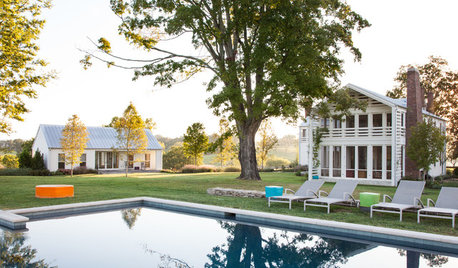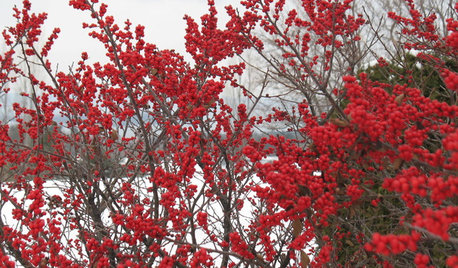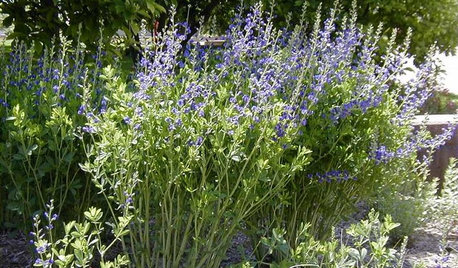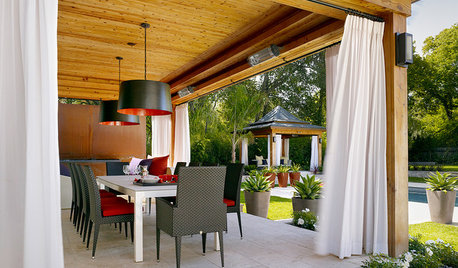A while back I said I would post a topic about my tree planting plans for the new 6 acres we bought last fall. I have been doing a lot of thinking, and posted one topic about what to plant on the "nose" of a little hill last fall. Well, here is a fuller description of the new land and some thoughts about what I will plant.
First, here is what the property is: We built our house on a large--8 acre lot 5 years ago. The lot is a narrow rectangle about 275 feet wide and about 1,200 feet deep. The very back acre or so is woodland--not a very good woodland, but there are a few nice trees, such as black locust , black walnut, and hickory. Then the three acres or so in front of that is a field that I have been letting grow up with whatever volunteers itself. But I have planted a few trees here and there, and have worked to control vines and some other noxious weeds. Then the front 4 acres or so is the house and lawn with a lot of trees planted. On this original 8 acres I have about 100 kinds of trees, including species and cultivars. Some of these are volunteers and native trees in the back woodland.
The new 6 acres is another narrow rectangle running parallel to our NE boundary. This new parcel is 225 feet wide and about 1,200 feet deep, with the back acre or so woodland. So the total width of the lot is now about 500 feet.
The most basic part of my plan is to create a screen between my land and the adjoining land, which is prime land for development and which is for sale. I expect some kind of development to be put in there as soon as the real-estate market recovers. For the main part of this screen I am planning to plant Norway spruce, one of my favorite trees. I have thought about a double row screen with trees planted 10 feet apart, with the two rows about 8 or ten feet apart. Eventually I might thin out some of these trees if some grow weaker than others, but I may not live long enough to do that myself. But in the meantime, this should make a good basic screen.
But one thought I have had, is that instead of making a screen of NS that is basically even for a full length of almost 1,000 feet, I could break up the screen with a kind of "offset" pattern. That is plant about 75 feet along the property line (or a few feet inside), and then plant the next 50 feet further inside my property--maybe 40 feet or so, and so on. This will break up the solid line effect and make it more visually appealing. Well, just a thought.
Then another possibility I have thought about is maybe making the "offset" parts of the screen some other species. My wife wants me to plant more Green Giants, but I am not a big fan of clones, all exactly alike. But in one or two places planting a dozen or so as part of this offset screen, may be attractive.
Another species I thought of as a part of an offset screen would be blue spruce, which also grow wonderfully well here in the Winchester, VA area.
Well, the screen is the main part of my plans, but I also want to plant some trees for fall color in front of the screen. I am thinking of getting some seedling red maples, some sugar maples, and planting a couple of groups in front of the screen. The same with some sweet gums, and maybe a few black gum (tupelo) trees. Then a couple of golden/Prairie Cascade willows for winter color. The idea is to not just to have a screen, but to have a backdrop for our land that has a lot of aesthetic appeal--Something to look at, and not just to block something we dont want to look at.
Much of the new property I will keep open, but in the back, next to the existing woodland, I am thinking about having an acre of new woodland planted (or volunteers). What kinds of trees? Wow, I really donÂt know. I donÂt think I will do anything with that idea this year.
But scattered, or in groups, I want to plant specimen trees in the area I will basically keep open. On the original lot I have a little grove of white pine planted. I would like to extend that. Then I would like to have a few other trees such as tulip tree, sycamore, some of the oaks/hybrid oaks I am planning for the nose of the little hill. And I have other possibilities, too numerous to name right now. One can plant a lot of trees on 5 acres--not including the back acre that is already wooded.
One really big problem--the deer. They destroy everything here that is not stoutly protected. Maybe I should set up another topic for that. But if I plant 200 Norway spruce trees, how the heck will I keep them protected from deer that will buck thrash them right down to ground level??? Use 200 of my wire cages made from woven wire cattle fencing? Oh lord, what a job!! I have heard that if buck rubbing, and not browsing is the main threat, that putting a 4 foot "T" post next to each one will protect them. That makes sense and is not so expensive or costly. But the other trees that are so nibble prone?? I have been fencing trees from deer until I am blue in the face, and now I will have several hundred more to protect--hey, I am just an old man! Have mercy, you stinking tree eating and tree thrashing critters!
--Spruce
















MissSherry
quirkyquercus
Related Discussions
Plants recommandation for our new house
Q
Our new Dick Clark & Love Song planted one month ago
Q
New Jersey - our first fig plant - what should I do?
Q
NEW: Plant, Bulb, etc. Swap ~Cracked Pot Gardner's~ April
Q
cascadians
wisconsitom
sprucemanOriginal Author
wisconsitom
sprucemanOriginal Author
Pamchesbay
naturalstuff
wisconsitom
sprucemanOriginal Author
Pamchesbay
sprucemanOriginal Author
Pamchesbay
wisconsitom
sprucemanOriginal Author
wisconsitom
conifers
sprucemanOriginal Author
redwood4
wisconsitom
sprucemanOriginal Author
conifers
sprucemanOriginal Author
wisconsitom
sprucemanOriginal Author
sprucemanOriginal Author
wisconsitom
greenfreak
sprucemanOriginal Author